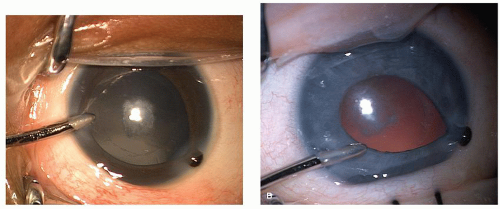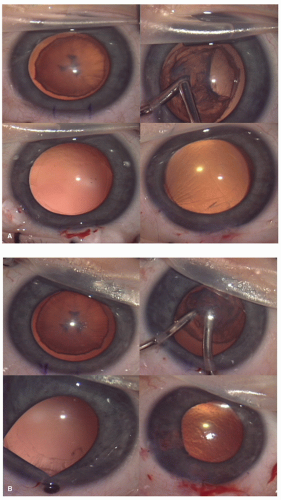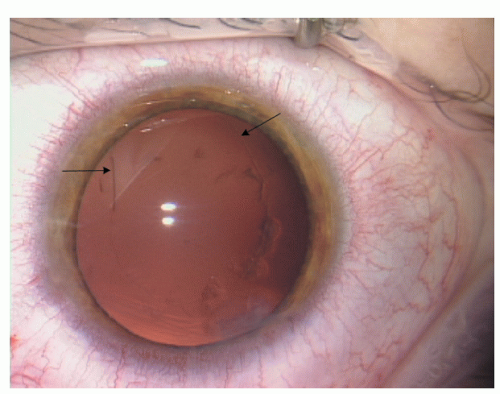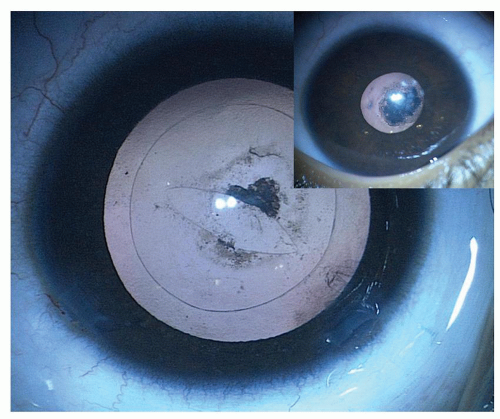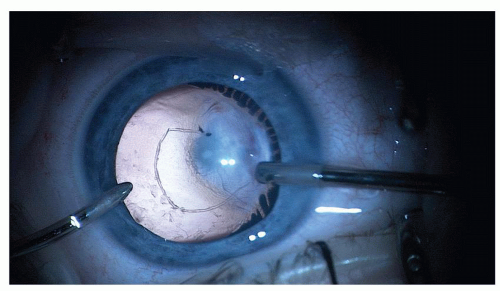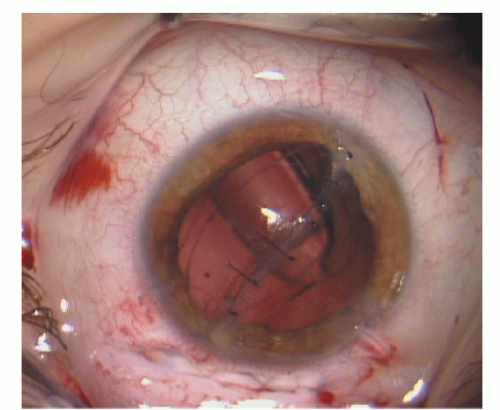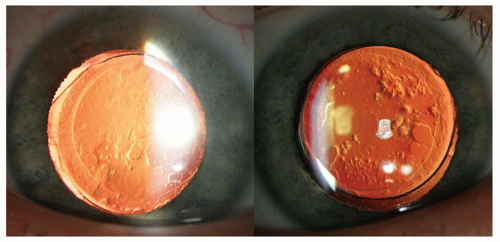Intraoperative and Postoperative Complications
Rupal H. Trivedi
M. Edward Wilson
Cataract surgery complications in children are higher as compared to adults. Intraoperative complications are higher as a result of the smaller size of the eye, sometimes poorly dilating pupil, highly elastic anterior capsule, low scleral rigidity, and increased intralenticular/intravitreal “pressure.” Postoperative complications are higher due to an increased inflammatory response. The rate of intraoperative complications is inversely proportion to the age at surgery. In addition, failure to achieve pupil dilation is an important risk factor. Detection and diagnosis of the complications can be challenging because of the difficulties encountered in performing detailed postoperative examinations in children, who may be uncooperative.
INTRAOPERATIVE COMPLICATIONS
Closed chamber surgical techniques using tunnel incisions and bimanual irrigation/aspiration as well as the use of high-viscosity ophthalmic viscosurgical devices (OVDs) have helped us to minimize iris touch and improve intraoperative performance. Primary intraocular lens (IOL) implantation may increase the risk of intraoperative complications. Results of the Infant Aphakia Treatment Study (IATS) reported that intraoperative complications were observed in 11% (6/57) of the eyes of the no-IOL group versus 28% (16/57) of the eyes of the IOL group.1
Iris and Pupil
Iris Prolapse
Iris prolapse is more frequently observed during pediatric cataract surgery as compared to adult (Fig. 49.1A and B). This results from the less rigid, softer corneal tissue and the very floppy iris tissue of the infant or young child. Iris may come into even a well-constructed corneal tunnel or even a paracentesis with an adequate internal lip. Overfilling the anterior segment with OVD may contribute to the iris prolapse. Iris entering the internal opening of a well-constructed wound is more common in infancy and almost never occurs in older children. Care must be taken to not traumatize the iris when this occurs as instruments enter and leave the eye. Incisions should be constructed to provide a snug fit for the instruments that pass into the anterior chamber (AC). Smaller wounds and tunnel configurations decrease the incidence of iris prolapse during surgery. Iris prolapse during surgery was observed in 4% (2/57) of the eyes of the no-IOL group and 21% (12/57) of the eyes of the IOL group (P = 0.008) in IATS.1 The authors attributed this fivefold increase in the IOL group to a larger wound size and the greater intraocular manipulation required to implant an IOL. Iris damage and postoperative iris transillumination defects may be observed in eyes with iris prolapse, especially in blue-eyed babies.
Intraoperative Miotic Pupil
A pupil may fail to dilate preoperatively due to anterior segment dysgenesis/iris hypoplasia, or a well-dilated pupil may constrict due to surgical manipulation/iris touch. Use of 0.5 mL of 1:1,000 adrenaline (epinephrine) in 500 mL of irrigating fluid is essential to maintain pupillary dilation throughout the surgery. Use of OVD can help to improve or maintain pupil dilation as well.
Since the management of pediatric surgery in the presence of a small pupil (Fig. 49.2) is not discussed elsewhere in this book, we include here a brief summary of options available to remove a cataract in the presence of a small pupil (as cited in Ref.2). The solution may be as simple as manipulating the pupil edge using a second instrument such as an aspiration handpiece or an iris repositor or iris hook. As each quadrant is operated, the second instrument is used to expose that quadrant by holding back the iris and working under it. Iris hooks (1-5) can also be placed through small self-sealing corneal openings to pull back the iris in all quadrants or just in those where the second instrument method does not work. These are easy to insert and can be selectively tightened or loosened to allow visualization of the peripheral lens material
while not overly traumatizing the iris. Iris hooks come in a packet of five disposable and adjustable hooks. The intent of the manufacturers is for the surgeon to use four to hold the pupil open in a square shape. There is one additional hook included in the package as an extra. Some surgeons use all five and create the shape of a “home-plate” in baseball. Even in babies, these wounds do not need suture closer when made properly. It is our recommendation that surgeons consider using these iris hooks more often when pupils are small. The extra time to place the hooks is well worth it to insure that all peripheral lens cortex is visualized and removed completely.
while not overly traumatizing the iris. Iris hooks come in a packet of five disposable and adjustable hooks. The intent of the manufacturers is for the surgeon to use four to hold the pupil open in a square shape. There is one additional hook included in the package as an extra. Some surgeons use all five and create the shape of a “home-plate” in baseball. Even in babies, these wounds do not need suture closer when made properly. It is our recommendation that surgeons consider using these iris hooks more often when pupils are small. The extra time to place the hooks is well worth it to insure that all peripheral lens cortex is visualized and removed completely.
Pupil expander rings represent another option in the surgical armamentarium for small pupil cases. The Hydroview Iris Protector Ring (Grieshaber) forms a compressed oval in its dehydrated state. It can then be placed in the AC and inserted into the small pupil. This hydrogel device expands with hydration and captures the pupillary margin by means of flanges. The ring can be manipulated to expand the pupil as it hydrates. The device can then be removed at the end of surgery through the same small incision. The Morcher Pupil Expander Ring Type 5S is a solid polymethylmethacrylate (PMMA) ring that is placed at the pupillary margin and expands the pupil. It reduces the likelihood of iris sphincter tears and postoperative pupillary deformity. Following implantation of the IOL, the ring is removed. An injection device is also available for the ring from Geuder. The Perfect Pupil (Becton, Dickinson) represents another effective option for both maintaining mydriasis and protecting the pupillary margin during surgery. This polyurethane device features a 7-mm internal diameter and an available injection device. Another helpful and easy-to-use expansion ring is the Malyugin Ring (MicroSurgical Technology [MST]). Its use has also been reported for pediatric cataract surgery.3 This ring is supplied with a disposable injector that compresses the ring to allow its insertion and then its controlled expansion within the eye. The smaller version of the Malyugin Ring is recommended when operating on children. The full 7-mm size can be overly traumatic for a small soft eye. Alternatively, the Beehler pupil dilator (Moria #19009) stretches the pupil to 6 to 7 mm while usually creating tiny micro-sphincterotomies circumferentially around the pupil. The pupil can then be mechanically reduced at the end of the procedure with an intraocular miotic agent.
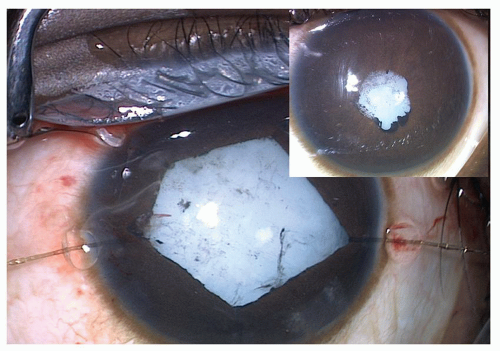 Figure 49.2. Use of iris hook in a 12-year-old child operated for cataract with small pupil. Inset shows preoperative view. |
Lastly, some miotic pupils in children are fibrotic and return to their sub-2-mm size after stretching. Reoperations for these miotic and nonreactive pupils require larger radial sphincterotomies or a pupilloplasty using the vitrector handpiece to remove a portion of the fibrotic pupillary edge. Care must be taken to not remove too much iris. If done properly, the cosmetic appearance of
the pupil can be surprisingly good although reactivity to light is still absent.
the pupil can be surprisingly good although reactivity to light is still absent.
Pediatric Intraoperative Floppy Iris Syndrome
The intraoperative floppy iris syndrome (IFIS) includes a triad of intraoperative signs: iris billowing and floppiness, iris prolapse, and progressive miosis. We reported pediatric IFIS in a 4-month-old child with bilateral cataract.4 Surgery in the right eye was uneventful (Fig. 49.3A). During removal of the cataract in the left eye, signs of IFIS were observed (Fig. 49.3B). The surgical technique was identical in both eyes except that epinephrine was added to the irrigating solution in the right eye but inadvertently omitted in the left eye surgery. Our case highlighted the importance of epinephrine in pediatric cataract surgery. Of note, pediatric IFIS was also reported in the case of a 1-month-old girl with bilateral persistent pupillary membranes without cataracts.5 It is our contention that many, if not all, infants have a floppy iris and that preoperative dilation with strong mydriatics and epinephrine placed in the irrigation solutions are necessary steps to reduce the effects of the naturally floppy iris. Without the intraocular epinephrine, iris prolapse into even the smallest wound would be even more common with infant surgery.
Collapse of Anterior Chamber
Fluctuation of AC depth occurs frequently in soft pediatric eyes. Techniques mentioned to avoid iris prolapse (tight fit wounds) also help to maintain a stable and deep AC. Bimanual irrigation/aspiration approaches help to avoid AC fluctuation. Some surgeons prefer to use an AC maintainer rather than holding both instruments as in bimanual surgery. An unstable AC usually results from too much leak around the instruments that are placed in the AC. Venturi pump machines often have a fluid pump that can be increased to offset the leak. Gravity-fed irrigation systems are not as effective. The surgeon must also learn to balance the aspiration with the irrigation in a way that does not repeatedly shallow the AC during surgery. Repeated shallowing or flattening and then deepening of the chamber during surgery acts like extensive iris manipulation. It releases inflammatory mediators and results in a marked increase in postoperative inflammation as well as intraoperative miosis.
Anterior Capsule Tear
It is no longer a secret that anterior capsulectomy is notoriously difficult in infants and young children because of the extreme elasticity of the anterior capsule, scleral collapse causing positive vitreous pressure, and, at times, poor dilatation of the pupil. Rarely, an anterior capsule tear may be observed as soon as the AC is opened, caused by the sharp tip of the entrance knife, especially when the AC is very shallow. The availability of better operating microscopes and microsurgical instruments combined with higher-viscosity OVDs are helpful; however, “runaway rhexis” or tear extending out toward the equator is still frequently encountered (Fig. 49.4). For manual continuous curvilinear capsulorhexis (CCC), it occurs mainly during anterior capsulectomy. Once a manual CCC is achieved, the edge is very strong and will withstand intraocular gymnastics very efficiently. When a tear occurs during manual CCC, the surgeon should stop tearing, place more OVD, regrasp close to the tear edge, and pull toward the center of the pupil. If this does not recover the capsulectomy easily, conversion to a vitrectorhexis or to a Kloti diathermy capsulectomy has been successful for us. For vitrectorhexis and Kloti diathermy, a tear is more likely to occur during IOL implantation or irrigation/aspiration or after OVD removal. Care should be taken to avoid right-angled edges, which is a weak point and likely to tear during intraoperative maneuvering. If a right-angled edge is seen during the capsulectomy, it should be rounded out using the vitrector before completion of the capsulectomy. The sudden flat AC that can occur after the OVD is removed before the wounds are sutured can cause the IOL to move anteriorly and place stress on the capsulectomy edge. Every effort should be made to sew the wounds prior to complete removal of the OVD if possible. A temporary air bubble can be used at the end of the procedure as another way to avoid shallowing of the chamber as the wound suture is being tied. Chapter 17 describes studies reporting the intraoperative tear rate using different techniques and other specific issues related to anterior capsule management.
Inappropriate size and shape are also complications of the anterior capsulectomy that are seen more often with children than with adults. Surgeons are urged to go slow and pay particular attention to size, shape, and centration each time the capsulectomy edge is released. If the capsulectomy opening is too small, it can be enlarged after the IOL is inserted. If it is too large or poorly shaped, take care to get the haptics of the IOL under the capsulorhexis edge and place the haptics where the capsulectomy edges can be most easily seen. Every attempt should be made to cover the edge of the IOL optic with the capsulorhexis edge when possible.
Positive Vitreous Pressure
A high intraoperative vitreous pressure is produced as a result of scleral collapse due to low scleral rigidity, which results in forward movements of the iris-lens diaphragm. In pediatric eyes, the posterior capsule is often convex rather than concave from the surgeon’s viewpoint. We often remove the peripheral lens cortex first, leaving the central nucleus of the lens until last since it holds the posterior capsule back in a more flat or concave configuration. Use of a high-viscosity OVD (e.g., Healon GV) helps to maintain a deep AC and keep the iris-lens diaphragm back.
Posterior Capsule Tear
A posterior capsule tear is not as devastating to a pediatric cataract surgeon as it is to an adult cataract surgeon, because pediatric cataract removal often includes posterior capsulectomy and vitrectomy. However, an uncontrolled posterior capsule tear may still compromise the ability of the surgeon to safely place an IOL into the capsule. Posterior capsule tears may occur due to preexisting posterior capsule defects (Fig. 49.5). The surgeon can recognize a torn posterior capsule during lens aspiration by signs such as a sudden deepening of the AC. This occurs instantaneously as a rent appears in the capsule. As this occurs, the pupil will dilate in response to the deepening AC. Finally, during aspiration, lenticular particles/residual cortical matter falls away from, and will not come toward, the tip of the aspirator. This occurs because the tear in the posterior capsule alters the flow dynamics in the AC. Sometimes the presence of vitreous in the AC may also indicate a torn posterior capsule. The posterior capsule can tear during hydrodissection, irrigation and aspiration, capsular polishing, lens insertion, and OVD removal. Posterior capsule tear can also occur during incision enlargement with the sharp tip of the keratome.
In all cases, if the posterior capsular tear is entirely within view, a posterior capsulorhexis can be attempted. If the vitreous face is intact, this is done by placing OVD above and below the tear, pushing the vitreous face back, and allowing room to grasp the torn capsule. If the vitreous face is already broken, OVD is necessary only to stabilize the AC and make room for the forceps. Using a capsulorhexis forceps, the capsule is then gently torn to create a 360-degree posterior capsulorhexis. Failed attempts may result in extension of the tear and, if not already present, vitreous loss.
Alternatively, the vitrector handpiece can be used to round out the posterior capsule tear, remove residual cortex, and remove prolapsed vitreous. Pediatric surgeons are more likely to use this approach since the use of the vitrector is often more familiar than the use of a capsulorhexis forceps on the posterior capsule. Care should be taken to begin with a low flow so that the AC dynamics are not changed drastically when the instruments are placed in the eye. This could lead to an extension of the posterior capsule tear. Once rounded out, the posterior vitrectorhexis can be quite stable and resistant to further tearing. The advantage of the vitrector handpiece is that it can safely remove cortex when it is mixed with vitreous. It can also cut the capsule and vitreous simultaneously without undue traction of the vitreous base or retina. A Venturi pump-driven vitrector handpiece works best when used in this way.
Anterior Vitreous Face Disturbance
Anterior vitreous face (AVF) disturbance during posterior capsule rupture is well recognized in adult cataract surgery. However, in children, this is less of a problem because anterior vitrectomy has become an integral part of the surgical strategy. However, some surgeons prefer to err on the conservative side and avoid anterior vitrectomy in children 2 to 8 years of age. When performing a posterior continuous curvilinear capsulorhexis (PCCC) without vitrectomy, surgeons should watch for signs for AVF disturbance, and if seen, a vitrectomy should be performed. The subtle signs are a vitreous strand in the AC, vitreous strands attached to the capsule flap, and distortion of the anterior and posterior capsulorhexis. The later is considered a pathognomonic sign of AVF disturbance.6 Signs of an intact AVF include its bulging structure and its characteristic triamcinolone staining patterns recently documented by Sudhalkar et al.7 These include the homogenous staining pattern of three buttonholes, giving the impression of a tabletop configuration with three subramifications.
Residual Vitreous in the Anterior Chamber
Vitreous strands can remain in the AC. When this occurs, it should be removed using vitrector. A second instrument may be needed, through a paracentesis, to sweep the
vitreous strand away from the wound so that the vitrector handpiece can remove it. A taut strand of vitreous will not easily enter the vitreous cutter until its connection to the wound is broken. A pars plana approach to the anterior vitrectomy avoids this possible complication. Some surgeons use triamcinolone to identify any residual vitreous, while some choose to use miotics to look for peaking of the pupil.
vitreous strand away from the wound so that the vitrector handpiece can remove it. A taut strand of vitreous will not easily enter the vitreous cutter until its connection to the wound is broken. A pars plana approach to the anterior vitrectomy avoids this possible complication. Some surgeons use triamcinolone to identify any residual vitreous, while some choose to use miotics to look for peaking of the pupil.
Hyphema and Intraoperative Vitreous Hemorrhage
Intraoperative hyphema may occur and may or may not need to be cleared before wound closure.8 A small hyphema will clear spontaneously. Hyphema was noted in approximately 5% of eyes in the IATS.1 Vascularized plaques (Fig. 49.6) or patent hyaloid artery remnants may lead to intraoperative vitreous hemorrhage.
Complications of Pars Plicata Vitrectomy
Laceration of the equator of the capsular bag with the microvitreoretinal (MVR) blade is a possible complication of a pars plana incision. The entry with the MVR blade should be aimed toward the center of the vitreous cavity to avoid hitting the capsular bag. The capsule may still be distended with an OVD or irrigation fluid. Surgeons like to see the tip of the MVR blade in the pupillary space through the operating microscope before withdrawing it. The tendency is to advance the MVR blade too anteriorly. In very young infants, the entry is even closer to the limbus. In these cases, the MVR blade must be aimed at the optic nerve to avoid hitting the capsular bag. Another less commonly encountered complication is bleeding into the vitreous cavity. The vitrector cutter must be turned off before the handpiece is withdrawn. If not, the cutter may engage the tip on a ciliary process during handpiece withdrawal, causing profuse bleeding. If this occurs, intraocular cautery will likely not be needed but a full core vitrectomy will be needed to clear the blood. A retinal specialist will need to be consulted unless the surgeon is experienced in core vitrectomy techniques.
Intraocular Lens Complications
The most common intraoperative complication related to the IOL is malplacement or malpositioning of the implant on entry into the eye (Fig. 49.7). When PMMA IOLs were used, asymmetrical fixation was common, especially in infants—the leading haptic into the capsular bag but unintended placement of the trailing haptic in the ciliary sulcus. Placing an oversized rigid IOL into a small soft eye was a real challenge. After the leading haptic entered the capsular bag, the OVD often exited the eye through the large wound, the pupil became miotic, and the surgeon was pleased just to get the trailing haptic somewhere posterior to the iris. Posterior vitreous upthrust made dialing the lens into the capsular bag more difficult. The use of foldable IOLs has made this complication less frequent. The trailing haptic of the single-piece AcrySof® IOL can be manually placed under the capsulectomy edge using a push-pull instrument. A second hook can be used to pull the iris edge back for better visualization if needed. Care should be taken to place the haptics into the capsular bag before they have unfolded completely. Once the single-piece AcrySof® haptics have unfolded outside the capsular bag, they are more difficult to place into proper position manually. If this happens, the IOL optic should be displaced eccentrically within the capsular bag as much as possible before an attempt is made to pull the haptic out of the ciliary sulcus. The single-piece AcrySof® IOL does not dial easily.
Many pediatric surgeons choose to perform a primary posterior capsulectomy and an anterior vitrectomy prior to implantation of an IOL. An OVD is then used to inflate the remaining capsular “tire.” The IOL must be carefully aimed on entry so that it enters the capsular bag. Fearing the deep entry, some surgeons aim too anteriorly, and the IOL enters the ciliary sulcus. Unlike the situation mentioned earlier, where IOLs dial up into the ciliary sulcus due to vitreous upthrust, IOLs often dial through the posterior capsulectomy when a vitrectomy has already been performed. Even gentle dialing and gentle posterior force on the optic will send a soft foldable IOL through an even modestly sized posterior capsulectomy. In this
situation, the IOL is best removed and reinserted, rather than dialed. To avoid this complication and make IOL insertion easier, we recommend IOL insertion into an intact capsular bag prior to the posterior capsulectomy. The IOL haptics should be oriented 90 degrees away from the wound. This allows the vitrector to be placed under the IOL optic more easily for OVD removal or for primary posterior capsulectomy and anterior vitrectomy. To avoid the possibility of dragging a strand of vitreous back to the wound, we recommend removing the OVD after the IOL is in place but performing the primary posterior capsulectomy and anterior vitrectomy through the pars plana, leaving the irrigation cannula in the AC.
situation, the IOL is best removed and reinserted, rather than dialed. To avoid this complication and make IOL insertion easier, we recommend IOL insertion into an intact capsular bag prior to the posterior capsulectomy. The IOL haptics should be oriented 90 degrees away from the wound. This allows the vitrector to be placed under the IOL optic more easily for OVD removal or for primary posterior capsulectomy and anterior vitrectomy. To avoid the possibility of dragging a strand of vitreous back to the wound, we recommend removing the OVD after the IOL is in place but performing the primary posterior capsulectomy and anterior vitrectomy through the pars plana, leaving the irrigation cannula in the AC.
Zonular Dialysis
It should be noted that zonular dialysis greatly increases the risk of both vitreous loss and lenticular material sinking into the vitreous. Obviously, IOL implantation may be more difficult. The surgeon needs to evaluate the number of clock hours involved with the zonular dialysis and the surgeon’s ability to perform lens aspiration in this setting. When inserted into the capsular sac, an endocapsular ring provides a circumferential expansile force to the capsular equator. However, the endocapsular ring does not always stabilize the lens position and often entraps the lens cortex between itself and the lens capsule. Removal of the trapped cortex can be difficult, and in fact, attempts to do so can cause further zonule dehiscence. Nonetheless, expansion of the capsular sac is often desirable either during or after lens removal, and these devices enhance implant centration and reduce postoperative pseudophakodonesis. Intracapsular rings (e.g., Cionni ring and capsular tension ring segments) are available and are used frequently in adult cataract surgery.
The relatively short length of the iris retractor hook and the single-plane design may cause them to slip off the capsule easily during manipulation of the nucleus. In addition, short iris retractors do not extend into the capsular fornix and, therefore, do not offer support to this region. Because of some of these disadvantages, Mackool designed capsule retraction devices specifically shaped for the purpose of retracting the anterior capsule. According to experience during adult cataract surgery, multiple retractors can be placed at 45-degree intervals to provide reliable support to the capsule and the enclosed lens. The elongated return of the retractor extends into the capsular fornix and therefore functions to prevent attraction of the equatorial capsule to the tip of the aspiration handpiece. After lenticular material removal is complete, an endocapsular ring (standard or Cionni design) can be inserted prior to removal of the retractors and insertion of an IOL.
Other Rare Complications
Cloudy cornea, iris sphincterotomy, retained cortex, and lens fragments in the vitreous were reported as intraoperative complications in the IATS cohort.1
POSTOPERATIVE COMPLICATIONS
When comparing literature reports of postoperative outcomes, a cautionary note should be kept in mind. Results from different studies are difficult to directly compare because of common inconsistencies that include variations in age at surgery, surgical technique, and associated ocular pathology. Major factors to keep in mind when interpreting these results are as follows.
Age at surgery. Children who are the youngest at the time of cataract surgery may also be the ones most prone to subsequent complications. Some studies include only older children, while others have a predominance of infants.
Associated ocular anomalies. Eyes with associated ocular anomalies (such as “complex microphthalmia”) are at high risk for postoperative complications.
Etiology of cataracts. In general, eyes with traumatic cataracts develop a more severe inflammatory response after IOL implantation compared with eyes of similar-aged children with nontraumatic cataracts.
Posterior capsule and anterior vitreous management. Posterior capsule and anterior vitreous management greatly influences the ultimate maintenance of visual axis clarity and ultimate visual outcome in children.
Follow-up. Studies with longer follow-ups will have high rates of opacification. Eyes with an intact posterior capsule tend to opacify between 18 months and 3 years after surgery. Studies that include eyes with <3 years of postsurgical follow-up probably underestimate the incidence of posterior capsule opacification (PCO) in the study population. We have reported that eyes that undergo cataract removal in infancy and receive a primary posterior capsulectomy and vitrectomy (and AcrySof® IOL implantation) tend to be at risk for recurrent opacification mainly during the first 6 months after surgery.9 Therefore, studies of this population will predict long-term VAO accurately as long as 6 months of postsurgical follow-up is included.
With this background, we focus on the postoperative outcome of cataract surgery in children.
Visual Axis Opacification
Visual axis opacification (VAO) has been discussed elsewhere in this book. PCO or VAO is most common complication after cataract surgery in children (Figs. 49.8, 49.9, 49.10, 49.11, 49.12, 49.13, 49.14, 49.15). It is important to note that VAO may occur as closure of a posterior capsule opening, PCO in eyes with intact posterior capsule, lens reproliferation into the visual axis, pupillary membrane, reticular fibrosis of the AVF, or corneal edema/opacity. VAO may occur anytime after cataract surgery. For example, a case of soft lens matter recurrence causing VAO 17 years after the
surgical removal of congenital cataract was reported.10 As discussed throughout the book, primary posterior capsulectomy and vitrectomy are considered essential steps to prevent VAO in the management of pediatric cataract. Researchers are working on other options to prevent this complication (e.g., sealed capsule irrigation, see Chapter 50) (Fig. 49.16).
surgical removal of congenital cataract was reported.10 As discussed throughout the book, primary posterior capsulectomy and vitrectomy are considered essential steps to prevent VAO in the management of pediatric cataract. Researchers are working on other options to prevent this complication (e.g., sealed capsule irrigation, see Chapter 50) (Fig. 49.16).
Glaucoma
Glaucoma can occur during the early or late postoperative period. Although open-angle glaucoma is more common, angle-closure glaucoma is rarely observed (Fig. 49.17) (see Chapter 51).
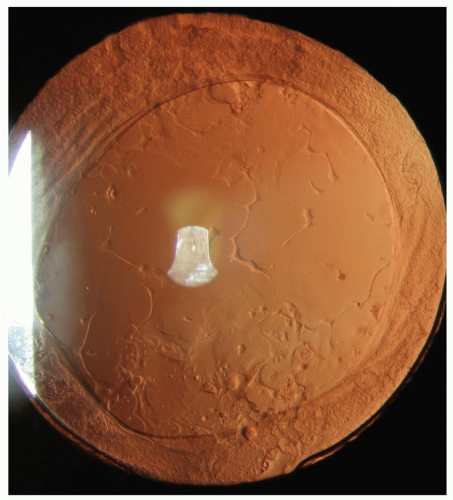 Figure 49.9. PCO documented 19 months after cataract surgery (posterior capsule was left intact, 26-D AcrySof® SN60WF IOL was implanted in-the-bag). |
Toxic anterior segment syndrome (TASS) is a rare inflammatory condition usually observed within the first 2 days after anterior segment surgery.11




Stay updated, free articles. Join our Telegram channel

Full access? Get Clinical Tree



